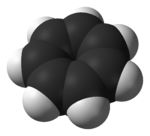- Tropylium cation
-
In organic chemistry, the tropylium ion is an aromatic species with a formula of [C7H7]+.[1] Its name derives from the molecule tropine (itself named for the molecule atropine). Salts of the tropylium cation can be stable, e.g. tropylium tetrafluoroborate. It can be made from cycloheptatriene (tropylidene) and bromine or phosphorus pentachloride [2]
It is a heptagonal, planar, cyclic ion; as well, it has 6 π-electrons (4n+ 2, where n=1), which fulfills Hückel's rule of aromaticity. It can coordinate as a ligand to metal atoms.



skeletal formula ball-and-stick model space-filling model The structure shown is a composite of seven resonance contributors in which each carbon carries part of the positive charge.
In 1891 G. Merling obtained a water soluble salt from a reaction of cycloheptatriene and bromine [3]. The structure was elucidated by von Eggers Doering and Knox in 1954 [4] [5]
Mass spectrometry
The tropylium ion is frequently encountered in mass spectrometry in the form of a signal at m/z = 91 and is used in mass spectrum analysis. This fragment is often found for aromatic compounds containing a benzyl unit. Upon ionization, the benzyl fragment is cleaved off as a cation (PhCH2+), which rearranges to the highly stable tropylium cation (C7H7+).
Electron ionization mass spectrum of toluene [1].
Note parent peak corresponding to molecular mass M = 92 (C7H8+) and
highest peak at M-1 = 91 (C7H7+, quasi-stable tropylium cation).References
- ^ IUPAC, Compendium of Chemical Terminology, 2nd ed. (the "Gold Book") (1997). Online corrected version: (2006–) "molecule".
- ^ Tropylium tetrafluorate Organic Syntheses, Coll. Vol. 5, p.1138 (1973); Vol. 43, p.101 (1963). link
- ^ Merling, G. (1891), Ueber Tropin. Berichte der deutschen chemischen Gesellschaft, 24: 3108–3126. doi:10.1002/cber.189102402151
- ^ The Cycloheptatrienylium (Tropylium) Ion W. Von E.Doering, L. H. Knox J. Am. Chem. Soc., 1954, 76 (12), pp 3203–3206 doi:10.1021/ja01641a027
- ^ Aromaticity as a Cornerstone of Heterocyclic Chemistry Alexandru T. Balaban, Daniela C. Oniciu, Alan R. Katritzky Chem. Rev., 2004, 104 (5), pp 2777–2812 doi:10.1021/cr0306790
Categories:- Simple aromatic rings
- Cations
Wikimedia Foundation. 2010.

